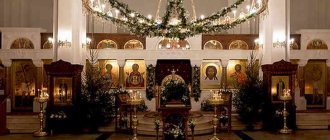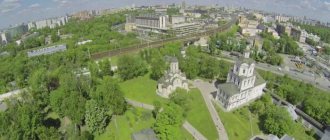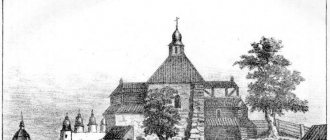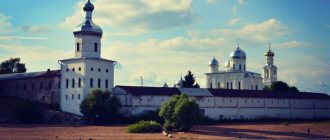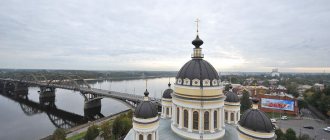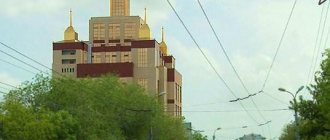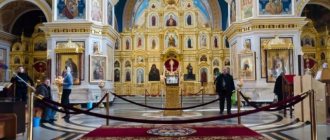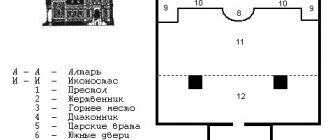St. Nicholas Church in Zelenograd is one of the few ancient monuments preserved on this land. For many decades, the city has been developing and being built, absorbing towns, villages, villages. So the Temple of St. Nicholas the Wonderworker, which was built on the Rzhavitsa River, in the village of Nikolskoye, back in 1756, ended up on the territory of the modern city as a result of its merger with surrounding settlements.
Initially it was wooden. However, like many churches of that time. The owners of the village of Nikolskoye were the Buturlins, then Prince Golitsyn, who resold it to Prince Dolgoruky. By 1827, the prince's son was rebuilding a stone church, where the priest, clerk and sexton began their service. St. Nicholas Church was the favorite parish of the residents of Rzhavka, Matushkino, Nazaryevo.
Historical events
In the 15th century, the area where Presnya flowed into the Moscow River was rich and picturesque. Here, with the blessing of Metropolitan. Photius, in seclusion on a hilly hill, the Novinsky Monastery was founded. In 1540, a solemn meeting of the miraculous image of the Blessed Virgin Mary, brought from Rzhev, took place. In honor of this significant event, a church was founded by decree of Tsar John IV. Time passed, and other buildings began to appear near the previously erected monastery, and the settlement grew. Over time, the Joshua Church was built.
Historians believe that it was the Temple of Joshua that gave the name to the Novinsk land. Temples that were built before the 18th century. were necessary for strengthening, which is why the monastery was often called a siege. During the period when the patriarchate disappeared in Rus' and was replaced by a synod, a misfortune happened in the monastery - a strong fire destroyed the entire monastery. The monks had nowhere to stay, and they went to other monasteries. In 1764, by decree of Empress Catherine II, the courtyard was officially abolished. The vacated land became available for private ownership.
St. Nicholas Church in Zelenograd
Start of construction
Over time, the Novinsky churchyard acquired an owner who decided to build a wooden church in honor of St. on the site previously occupied by a men's monastery. Nicholas the Wonderworker. There were several villages in the surrounding area. Later they became parts of Zelenograd, and at that time their inhabitants formed the parish of the temple. After 50 years, landowner Andrei Dolgorukov began to build a new, now stone temple.
In 1827, 25 years after the start of large-scale construction work, the winter (warm) church was consecrated. A year later, a temple was opened in which services were held during the warm season. At the same time, permission was given to dismantle the already dilapidated wooden church and transfer all the valuables to the new monastery. Gradually, new buildings began to appear near the temple: houses for priests, a women's almshouse near the bell tower.
By order of the Bolshevik authorities in 1918, the almshouse at the temple was liquidated. And along with it, all hospitals and shelters that had operated at churches until that time were banned. The church, and especially its bell tower, suffered greatly during the Second World War. When German troops were on the outskirts of the capital, the battle was adjusted from the bell tower of the temple.
The church suffered greatly during the Second World War
Restoration of the monastery
In 1963, construction of the city of Zelenograd began. It included a temple located in the village. Rzhevki. It became the oldest building of the young settlement. But only at the end of the 20th century. Restoration work began in the ancient monastery. Despite its significant historical and architectural value, government authorities did not allocate material resources for the restoration of the building. The restoration was carried out through donations from Orthodox Christians.
In the 80s XX century the six aisles of the temple and its bell tower looked like a pile of stones - the careless attitude of the atheistic authorities turned the church into ruins. What was required was not just restoration, but rebuilding. Through the efforts of ordinary parishioners, all the chapels of the temple were restored. In 1988, the first liturgy after a long forced break was celebrated in the dilapidated monastery. The first rector, Rev. V. Kharitonov managed to unite a friendly parish and organize parish life in the church.
The Zelenograd deanery includes several churches, a chapel and prayer rooms located in hospitals. All of them are currently attached to the St. Nicholas Church. The churches of St. St. Petersburg especially attract attention. Sergius of Radonezh and Metropolitan. Philaret of Moscow. Both temples are small churches made entirely of wood, including the domes. The ascribed church of St. Sergius of Radonezh stands against the backdrop of a city high-rise building, and the Philaret Church is in a secluded corner of the city.
Temples of the Zelenograd administrative district
St. Nicholas Church is part of the Zelenograd deanery. This is a district, part of a diocese, which unites several parishes. Before the revolution, such districts were called forty, hence the phrase “forty forty”; that’s how many churches there were in Moscow. They united on a territorial basis. The Zelenograd deanery unites churches located on the territory of the district. This is the Church of St. Nicholas of Myra, the Church of St. Philaret, the Church of St. Sergius of Radonezh, and several chapels. The city is developing and growing.
Taking into account the population’s need for worship and liturgy, the construction of three more modular churches is planned for the near future in the district. The construction of one of them, the Alexander Nevsky Temple, is already close to completion.
Architecture and appearance
An ancient wooden church, which preceded the stone temple, stood on the land of A. Dolgoruky. According to his plan, a new temple was erected, which was distinguished by a large-scale architectural complex with a towering bell tower in the center. The buildings, made of red brick, had a white finish and stood out strongly against the background of other buildings.
To create the new temple, an unusual style called pseudo-Gothic was used. In addition to the main church, on the territory of the monastery there is a Sunday school, a library of spiritual literature for the parish, and also a building of sisters’ cells.
St. Nicholas Church in Zelenograd is included in the list of cultural heritage of the country.
History of the temple in Nikolsky Proezd
The population grew every year and by 1848 there were already more than 500 residents. In addition to the temple, an almshouse was set up on the territory for those who needed treatment and shelter. And it was supported by money from the capital of A. N. Dolgorukov. After some time, a zemstvo school was built for children and residents of nearby villages.
After the revolution, many churches were closed. They were robbed and destroyed. Until 1938, services were still held in the St. Nicholas Church, but nevertheless the authorities closed it and set up a warehouse. In 1941, fierce battles took place on the territory of the future complex and the buildings were badly damaged. The church's bell tower housed an artillery fire spotter, and the Germans spared no effort in destroying this point. After the war, it was decided to remove the bell tower completely by blowing it up. But, falling, she damaged nearby buildings, leaving only sad memories of herself.
Interior decoration
The church historically has six chapels. Gradually they were completely restored and consecrated. During the work, the craftsmen relied on the available data about the old temple, so the new chapels have a significant similarity with the previous ones.
The gilded iconostasis of the church can be attributed to the decorations of the monastery. It is not impressive in height, but it is very skillfully made. The lightness of the interior atmosphere is emphasized by multiple wall paintings, done without using too dark tones.
The gilded iconostasis of the church is a decoration of the monastery
Recovery from serious devastation
But time does not stand still, and in the early 90s, serious restoration of the building began. At that time there were no rich people, and no patrons of the arts. Therefore, ordinary people collected money for the restoration of the temple, but the administration of the city of Zelenograd also helped the newly established parish. Initially, the church had six chapels, and the three-tier bell tower was also a unique structure.
And by the beginning of the restoration, all that remained of the bell tower were the side buildings and the lower tier. The building itself was at the stage of destruction. Therefore, the ministers of the St. Nicholas Church in Zelenograd, as well as the parishioners, faced a difficult task - to restore the temple to the same form as it was before the revolution. We had to start practically from scratch.
Social work
St. Nicholas Church is a people’s monastery, because social services and several institutions operate under its auspices.
The shrine with a 250-year history has become a place not only for communion with God, but also for the fulfillment of the Gospel commandments, the main of which is love for one’s neighbors. For about 25 years, children and adults have been learning the Law of God in Sunday school. Parishioners provide voluntary assistance to those in need in several areas:
- cleaning the apartments of sick and elderly people;
- walking with people confined to wheelchairs;
- classes with children according to the school curriculum;
- rehabilitation classes for disabled children;
- organization of holidays.
Interior of the upper temple of St. Nicholas Church
Information for pilgrims and tourists
The ancient church of a young town near Moscow is a place of pilgrimage for Orthodox Christians. There are several hotels of different levels in the city, which gives each guest the opportunity to stay in Zelenograd for several days and get acquainted with all the shrines and attractions.
Several times a year, excursions take place around the territory of the temple and monastery. You can find out about organizing excursions by calling the official website of the deanery https://zelen-hram.ru/.
Patronal holidays
The following patronal feasts are celebrated in the St. Nicholas Church:
- Resurrection of Christ (movable date);
- December 19 and May 22 – St. Nicholas the Wonderworker;
- October 14 – Intercession of the Most Holy Theotokos;
- December 7 – martyrdom. Catherine;
- August 12 – St. John the Warrior;
- August 20, September 21, December 6 – St. Mitrofan of Voronezh.
Schedule of services
The doors of the church are open to Orthodox Christians every day from 8:00 to 20:00. On Sundays and holidays the temple is open from 6:00. The liturgy begins at 9:00, and the evening service the night before begins at 17:00. Every Thursday an akathist is read to St. Nicholas of Myra.
Patronal holidays are celebrated in St. Nicholas Church
Where is it and how to get there
The church is located at: Nikolsky proezd, 1. To get there, you need:
- from the Rechnoy Vokzal metro station take bus No. 400, 400E, get off at the stop. "Moscow avenue";
- From the Kryukovo railway station, take bus No. 12 to the stop. "St. Nicholas Church".
The journey from Moscow to Zelenograd takes about an hour. You can take a taxi or bus.
Author's advice
St. Nicholas Church is the only surviving historical and architectural monument on the territory of the Zelenograd Autonomous Okrug. The monastery warmly welcomes pilgrims from Moscow and other cities of the country. Even though the temple is located in a small town, there is a lot to see here.
If you find an error, please select a piece of text and press Ctrl+Enter.
Beginning of work
The first services in St. Nicholas Church in Zelenograd began back in 1988 and did not stop for a day, even during restoration and repairs. Since then, daily services, morning liturgies, and all-night vigils have been held. On some days, akathists are read to St. Nicholas and the “Inexhaustible Chalice” icon of the Mother of God with a prayer service for water.
After restoration, all six chapels were restored in the church. This is the name of a specially designated part of the temple, where an additional altar with thrones is located. This complex structure allows for more than one liturgy per day.


